Tähtitieteellinen yhdistys Ursa
Ilmakehän optiset ilmiöt

Displays
26.4.
The south of Finland lay under the thick clouds of the North Russian low. In the central and northern parts were some breaks, which gave a freer view of the high clouds. This is easy to see on the basis of the observations of this day: No observations were made on the southern coast line, but in Kokkola Penttinen and in Oulu Syrjä, for example, succeeded in seeing some of the phenomena. Central Europe was crossed by several fronts belonging to a British cyclone and brought few cloud-gaps. Löwenherz seems to have been the only German observer of the day. The Netherlands got similar conditions, in Deventer Peter-Paul Hattinga Verschure managed to see some familiar forms.

Satellite image: Apr 26, 12:19 GMT
26./27.4.
A short lunar 22° halo was caught by Gerhard Stemmler in Oelsnitz, Germany. Thus Stemmler became the observer to verify the last lunar halo of the project.
27.4.
Clouds, partly high, to the north of Finland were due to the North Russian low, while cirrus to the south was produced by part of the edge of a trough above the Baltic Sea. Probably the best display of Finnish Capital area of the whole April was observed on this very day. Sillanpää: "The altostratus layer begun to get thinner and thinner in the afternoon and a bright 22° lower tangent arc appeared near the western horizon. It seemed as if a display was coming". The display peak was after all a bit disappointment for Mika as he was awaiting for something still better. There were however in the sky for example both infralateral arcs for many hours, fully developed circumscribed halo for a while, and a faint 9° halo for many hours as well. The 9° halo was so faint Mika could not see it without the convex mirror. Anne Jokinen at her turn managed to see the 9° halo a few hours later. At Kuusankoski, (Southern Finland as well), the experienced halo hunter Eero Savolainen saw the faint 9° halo already at 7:30 GMT. These other observations fortunately give support to Jokinen's observation that was originally reported as uncertain. Aikioniemi in Savukoski got fine halos again. "Cs-area brought into existence a really bright thing around the Sun. Dazzling parhelia, solar side parhelic circle, bright upper tangent arc and the 22° halo". Swathes of other high clouds influenced the halo-production in Eastern Germany and Northern Austria. A warm front which stretched from the British Isles to France created several cirrus fields for the Netherlands and North-Western Germany. A clear result for this is seen in the amount of observations for the day, although in Netherlands the observers were not very lucky. Holger Lau has mentioned a short sun pillar in Pirna.
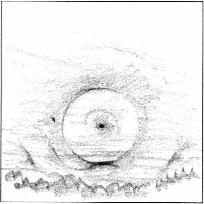
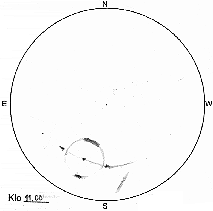
Satellite image: Apr 27, 12:08 GMT
28.4.
Southern Finland halo gang got another good day in succession. The ridge of an Atlantic anticyclone held out its arms to those regions and promoted some breaks in the lower clouds. Cirrus was sponsored by a warm front above the Baltic Sea. The north lay under thicker clouds from a Nordic cyclone.Sillanpää took the Parry arc in the morning in Helsinki, Kaivopuisto when preparing for the First of May student celebration. A cirrostratus with very long fibres created a sharp Parry thing there for a few minutes; just enough for it to get into film. In the evening, Marko Pekkola captured the Parry arc also. "A cloud area soon filled the sight. The right parhelia was a bit later visible. I was uncertain of the Parry until I heard the others also had observations of it", Pekkola confirms. A bit earlier, Eero Savolainen at Kuusankoski saw the Parry arc as well.
Above Germany lay the trailing cold front of the British low, which brought weak cirrus. Among of the few reports lies the one made by Michael Dachsel, who had the pleasure of 22° halo in Chemnitz.
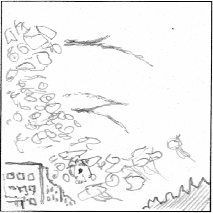
Satellite image: Apr 28, 11:57 GMT
29.4.
In Central Europe British high brought to a large extent cloud-free weather, and only very occasional cirrus visited the sky to the north, so an observation for this date is a rare sight. Hard core enthusiastics Hetze, Hinz and Kaiser saw some poorly developed displays, but the richest combination is reported by Löwenherz, whose observations contain for example 46° halo.
A high pressure cold formed between a British high and another high with its heart over Northern Finland. A low pressure above the Baltic Sea sent its warm front to South-Eastern Finland. Low clouds were already there, but in the west of Central Finland cirrus was still apparent.
Eerik Viitala captured a major column crystal display in Jyväskylä, Middle Finland. This display is probably the second best display of Finland in April. "...there was a clear and coloured (mainly bluish) anthelion visible. In the photos, the anthelion is clear but the colours are absent. This is how it often goes with faint colours". According to simulations, there should be nothing but white near the anthelic point. The colours hence remain unresolved. The V-shape under the anthelion should be originated by the Greenler or Tricker anthelic arcs, or both. Eerik also reported a very uncertain Liljequist parhelion in the display.
In Tikkakoski near Jyväskylä, Reima Eresmaa observed the same display. Concerning his experiences at about 6-7 GMT, Eresmaa writes "I happened to be serving my country in Tikkakoski garrison.... luckily, I could sometimes even go out and have a look at the halos. The upper tangent arc was absolutely among the best ones I've ever seen. Above that, there was a clearly coloured, not very sharp Parry arc". Later, at noon when soldier Eresmaa was allowed to have lunch: "When making a three-line behind the lorry, from time to time I had a look at the sky-- WELL--- most probably a perfect parhelic circle, and after a while a realized there was a clear arc above the parhelic circle against a perfectly smooth cloud layer. It's the Wegener there!" Army seems to be one of the things that constraints halo observing most. Reima's experience is not the only one, unfortunately.
Tarmo Palojärvi at Savukoski noticed an interesting pyramidal display. The left 18° lateral arc (18° parhelion) is quite a clear case. The other halos in the display are however not very easy to identify. The ring halo should perhaps be the normal 22° halo, with pieces of the circumscribed halo as enhancements on the top and bottom of it. The short arc above the circular halo is reported by Tarmo as the 23° parroid (23° parhelion), which seems very reasonable as the mutual display of 18° and 23° halos is typical among pyramidal halo displays. The piece of a halo on the left was reported by Tarmo as the 24° ring. The complete lack of the Van Buijsen 9° halo does not back up this assumption (the crystals that create visible enough 24° halos, bring in practice always powerful, record strong 9° halos). The other identification possibility is the 23° ring, but then the two halos (22° and 23°) would hardly be so well separable from each other as in the drawing. Unfortunately there are no photographs to further analyse the interesting pyramidal features offered by Palojärvi. Congratulations anyhow to Tarmo of the sky gem.
The new observer Pertti Kovala at Saarijärvi writes "on Tuesday 29.4. there was a fine halo display in the sky, from the early morning until late afternoon". Pertti send his slides of the display to Helsinki, and the photos really show a beautiful display, the Parry arc probably being the rarest halo of all.
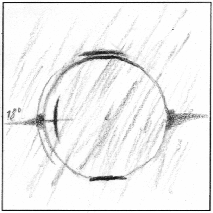
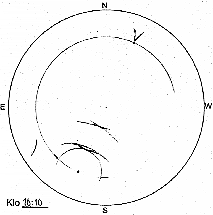
Satellite image: Apr 29, 11:46+13:26 GMT
30.4.
The situation was poor for the Finns: on the morning some observers had noticed a 22° halo. In Central Europe British high brought to a large extent cloud-free weather, and only very occasional cirrus visited the sky to the north. One of the few who received gifts of halos was Dieter Klatt, who managed to see even a circumzenithal arc. Dieter's display had the greatest variability of the day in Europe. Also in England observers reported about the same kind of displays with forms originating likewise in plate crystals: Les Cowley went on to caught a parhelion and circumzenithal arc in the final evening of the month at Chester, England. Breman noticed an occasionally appearing 22° halo in Veenhuizen.
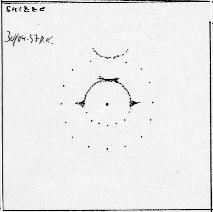
Satellite image: Apr 30, 11:35+13:15 GMT
European Halo Project | Contents | Previous chapter | Next chapter
-
 Useita halomuotoja II 2.1.2026 klo 20.34; Nivala; Heli Ojalehto
Useita halomuotoja II 2.1.2026 klo 20.34; Nivala; Heli Ojalehto -
 Harvinaisia halomuotoja IV 2.1.2026 klo 19.00; Oulu; Marja Marttila
Harvinaisia halomuotoja IV 2.1.2026 klo 19.00; Oulu; Marja Marttila -
 Useita halomuotoja II 2.1.2026 klo 19.00; Raahe; Irina Jylhä
Useita halomuotoja II 2.1.2026 klo 19.00; Raahe; Irina Jylhä -
 Yksi halomuoto I 2.1.2026 klo 18.00-18.01; Haapavesi; Osmo Hyvärinen
Yksi halomuoto I 2.1.2026 klo 18.00-18.01; Haapavesi; Osmo Hyvärinen -
 Useita halomuotoja II 2.1.2026 klo 13.00-13.10; Kajaani; Mervi Juntunen
Useita halomuotoja II 2.1.2026 klo 13.00-13.10; Kajaani; Mervi Juntunen -
 Useita halomuotoja II 2.1.2026 klo 12.30-14.00; Raahe; Mikko Silvola
Useita halomuotoja II 2.1.2026 klo 12.30-14.00; Raahe; Mikko Silvola -
 Useita halomuotoja II 2.1.2026 klo 11.00-14.00; Raahe; Irina Jylhä
Useita halomuotoja II 2.1.2026 klo 11.00-14.00; Raahe; Irina Jylhä -
 Keinovalopilareita II 2.1.2026 klo 2.00-3.00; Kempele; Marko Haapala
Keinovalopilareita II 2.1.2026 klo 2.00-3.00; Kempele; Marko Haapala
-
 Yksi halomuoto I 2.1.2026 klo 0.27; Parkano; Soili Jalava
Yksi halomuoto I 2.1.2026 klo 0.27; Parkano; Soili Jalava -
 Harvinaisia halomuotoja IV 2.1.2026 klo 0.25-4.10; Vaasa; Timo Alanko
Harvinaisia halomuotoja IV 2.1.2026 klo 0.25-4.10; Vaasa; Timo Alanko -
 Yksi halomuoto I 2.1.2026 klo 0.05-0.15; Kauhajoki; Anu Kilpiö
Yksi halomuoto I 2.1.2026 klo 0.05-0.15; Kauhajoki; Anu Kilpiö -
 Useita halomuotoja II 1.1.2026 klo 22.50-23.30; Seinäjoki; Pekka Lähteenmäki
Useita halomuotoja II 1.1.2026 klo 22.50-23.30; Seinäjoki; Pekka Lähteenmäki -
 Keinovalopilareita 1.1.2026 klo 22.00-22.30; Oulu; Ari Juntunen
Keinovalopilareita 1.1.2026 klo 22.00-22.30; Oulu; Ari Juntunen
-
 Useita halomuotoja II 1.1.2026 klo 22.00 - 2.1.2026 klo 7.00; Vaasa; Juha Varis
Useita halomuotoja II 1.1.2026 klo 22.00 - 2.1.2026 klo 7.00; Vaasa; Juha Varis -
 Yksi halomuoto I 1.1.2026 klo 21.47; Simo; Joni Alavesa
Yksi halomuoto I 1.1.2026 klo 21.47; Simo; Joni Alavesa
![[EHP]](fileadmin/_migrated/RTE/RTEmagicC_664970cc8d.gif.gif)
